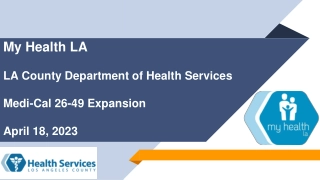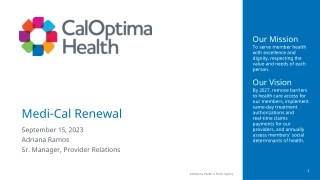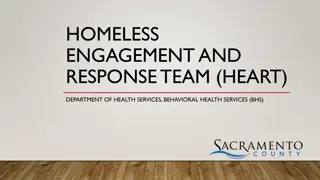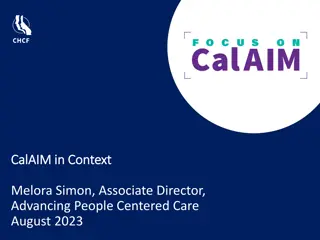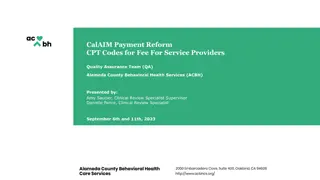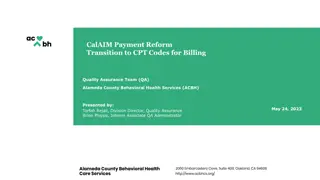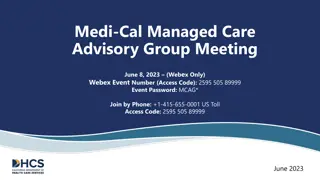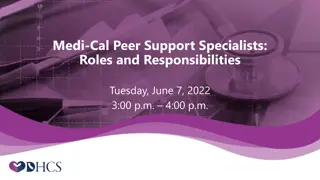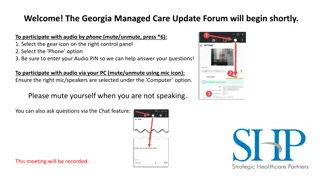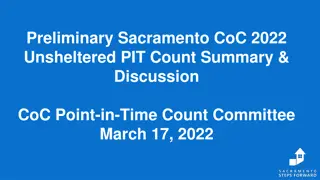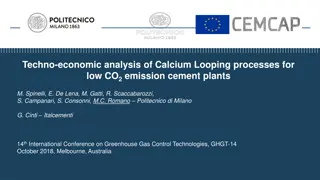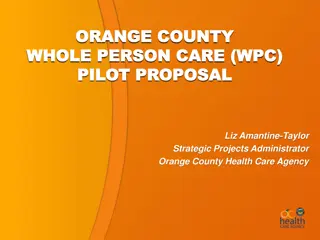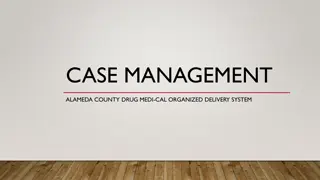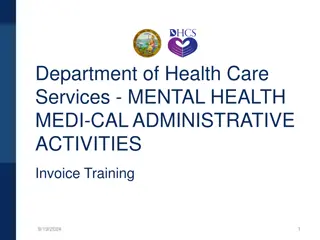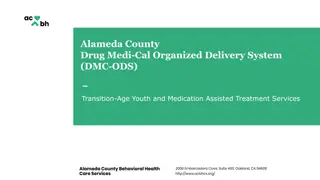CalAIM Implementation Updates in Sacramento County: Enhancing Medi-Cal Managed Care and Community Supports
CalAIM implementation in Sacramento County includes collaborative efforts in enhancing Medi-Cal Managed Care Plans (MCP) and implementing services like Enhanced Care Management (ECM) and Community Supports (CS). The joint MCP collaboration activities involve standing workgroups, roundtables, streamlined application processes, and aligned investments in various programs to improve population health management. The ECM benefit aims to provide coordinated support for members with complex care needs, while CS services address health-related social needs for healthier living and reduced care costs.
Download Presentation

Please find below an Image/Link to download the presentation.
The content on the website is provided AS IS for your information and personal use only. It may not be sold, licensed, or shared on other websites without obtaining consent from the author.If you encounter any issues during the download, it is possible that the publisher has removed the file from their server.
You are allowed to download the files provided on this website for personal or commercial use, subject to the condition that they are used lawfully. All files are the property of their respective owners.
The content on the website is provided AS IS for your information and personal use only. It may not be sold, licensed, or shared on other websites without obtaining consent from the author.
E N D
Presentation Transcript
CalAIM Implementation in CalAIM Implementation in Sacramento County Sacramento County Program Updates Program Updates for Sacramento County Health Authority for Sacramento County Health Authority Commission Commission January 16, 2024 January 16, 2024
Todays Purpose 1.Overview of Medi-Cal Managed Care Plan (MCP) CalAIM Collaboration 2.Enhanced Care Management (ECM) Benefit and Community Supports Implementation Update 3.Street Medicine Implementation Update 4.Looking Ahead What s Next in 2024? 2
Overview of Medi Overview of Medi- -Cal Managed Care Cal Managed Care Plan (MCP) CalAIM Collaboration in Plan (MCP) CalAIM Collaboration in Sacramento County Sacramento County
MCP CalAIM Collaboration in Sacramento County Sacramento Medi-Cal managed care plan (MCP) collaboration is a cornerstone of CalAIM implementation in Sacramento County. Joint MCP collaboration activities, include but are not limited to, the following: Joint standing workgroups with Sacramento County and Sacramento Steps Forward Launched Sacramento County CalAIM Roundtables in 2022 to ensure there was a transparent, inclusive forum to engage stakeholders to assess CalAIM implementation in Sacramento County. Partnered on joint ECM and Community Supports application process to minimize provider burden Aligned on joint ECM Referral Form to minimize provider burden Collaborated on joint investments: CalAIM Incentive Payment Program (IPP) Housing and Homelessness Incentive Program (HHIP) Student Behavioral Health Incentive Program (SBHIP) investments Aligned on joint Population Health Management (PHM) Program Strategy Deliverable SMART goals 4
Enhanced Care Management (ECM) Enhanced Care Management (ECM) Benefit and Community Supports Benefit and Community Supports Implementation in Sacramento Implementation in Sacramento County County
A Journey to a Healthier California for All CalAIM is a long-term commitment to transform and strengthen Medi-Cal, making the program more equitable, coordinated, and person-centered to help people maximize their health and life trajectory. ENHANCED CARE MANAGEMENT (ECM): ECM is a benefit, and is intended to be rendered in person The role of the ECM provider is to coordinate all services and supports for the member, including participating in the care planning process, regardless of setting Serves specific Populations of Focus who have complex care needs or are otherwise vulnerable COMMUNITY SUPPORTS (CS): Community Supportsare services that help address members health related social needs, help them live healthier lives, and avoid higher, costlier levels of care Community Supports Services (14 services in all): Housing: Navigation Services, Deposits, Tenancy and Sustaining Short-Term Post-Hospitalization Housing and Recuperative Care Day Habilitation Programs and Sobering Centers Nursing Facility Transition/Diversion to Assisted Living Facilities Community Transition Services/Nursing Facility Transition to a Home Respite Services, Personal Care and Homemaker Services Environmental Accessibility Adaptations (Home Modifications) Meals/Medically-Tailored Meals or Medically-Supportive Foods Asthma Remediation ECM Core Service Components: Outreach & engagement Comprehensive Assessment & Care Management Plan Enhanced Coordination of Care Health Promotion Comprehensive Transitional Care Member & Family Supports Coordination of Referral to Community & Social Support Services 6
Enhanced Care Management (ECM) Benefit Populations of Focus Individuals Experiencing Homelessness: Adults without Dependent Children/Youth Living with Them Experiencing Homelessness Individuals Experiencing Homelessness: Homeless Families or Unaccompanied Children/Youth Experiencing Homelessness Individuals At Risk for Avoidable Hospital or ED Utilization (Formerly High Utilizers ) Individuals with Serious Mental Health and/or SUD Needs Individuals Transitioning from Incarceration Adults Living in the Community and At Risk for LTC Institutionalization Adult Nursing Facility Residents Transitioning to the Community Children and Youth Enrolled in CCS or CCS WCM with Additional Needs Beyond the CCS Condition Children and Youth Involved in Child Welfare Birth Equity Population of Focus
2023 Q3 ECM Enrollment Data Sacramento County Population of Focus Aetna Anthem HealthNet Kaiser Permanente Molina Total Q3 2023 Q3 2023 Q3 2023 Q3 2023 Q3 2023 Q3 2023 Adult At Risk for Institutionalization eligible for LTC 58 36 1 4 4 81 Adult Experiencing Homelessness 130 370 170 221 19 540 Adult High Utilizers 363 311 494 115 309 1305 Adult Nursing Home Transition to Community 15 4 21 0 0 38 Adult Transitioning from Incarceration (WPC) 0 4 9 - 6 16 Adult SMI/SUD 343 797 251 202 318 1227 Child Homelessness 2 8 2 42 0 46 Child High Utilizers 0 3 4 7 14 25 Child SED 6 10 11 38 2 57 Child Child Welfare 2 0 3 17 0 22 Child CCS 2 0 2 2 0 6 Total 921 1543 1106 648 672 4890
2023 Q3 Community Supports Enrollment Data Sacramento County
Aligned MCP CalAIM Incentive Payment Program (IPP) Investments in Sacramento County Joint MCP IPP Investments Amount IPP Round 1 15 Sacramento County providers funded $3,527,015.32 IPP Round 2 16 Sacramento County providers funded $3,240,956.30 Sacramento County Social Health Information Exchange (SHIE) $9,863,796.00 Total $16,631,767.60 *Amounts to Sacramento County providers do not reflect funding a provider may have received through DHCS PATH Capacity and Infrastructure Transition, Expansion and Development (CITED) Rounds 1 or 2, or PATH Technical Assistance Marketplace.
Street Medicine Implementation in Street Medicine Implementation in Sacramento County Sacramento County
The fundamental approach of street medicine is to engage people experiencing homelessness exactly where they are and on their own terms to maximally reduce or eliminate barriers to care access and follow-through. Street Medicine Institute
Street Medicine Overview Street medicine refers to a set of health and social services developed specifically to address the unique needs and circumstances of individuals experiencing unsheltered homelessness, delivered directly to them in their own environment through street medicine providers in the role of the Member s assigned Primary Care Provider (PCP), through a direct contract with the Plan, as an ECM Provider, as a Community Supports Provider, or as a referring or treating contracted Provider. Street Medicine Provider: Refers to a licensed medical provider (e.g., Doctor of Medicine (MD)/Doctor of Osteopathic Medicine (DO), Physician Assistant (PA), Nurse Practitioner (NP), Certified Nurse Midwife (CNM)) who conducts patient visits outside of the four walls of clinics or hospitals and directly on the street, in environments where unsheltered individuals may be (such as those living in a car, RV, abandoned building, or other outdoor areas). Primary Care Provider (PCP): Providers can elect to serve as PCPs. In order to serve as a PCP, the street medicine Provider must meet the Plan eligibility criteria for being a PCP, be qualified and capable of treating the full range of health care issues served by PCPs within their scope of practice and agree to serve in a PCP role.
Street Medicine Services Street Medicine Providers who choose to act as a Member s assigned PCP must agree to provide the essential components of the Medical Home in order to provide comprehensive and continuous medical care, including but not limited to: Basic Case Management (with transition to Basic Population Health Management when effective); Care coordination and health promotion; Support for Members, their families, and their authorized representatives; Referral to Specialists, including behavioral health Referrals to long-term services and supports, community-based organizations, and social support services, when needed; The use of Health Information Technology to link services, as feasible and appropriate; and Provision of primary and preventative services to assigned Members.
Street Medicine Referral Pathway to Specialists and other Services
Aligned MCP Housing and Homelessness Incentive Program (HHIP) Investments in Sacramento County Joint MCP HHIP Investments Amount Recipient Street Medicine Capacity Building $2,233,147 Various Providers Continuum of Care infrastructure support funds used to support staffing, consultation, technology, trainings; intake/referral network including data management and reporting/HMIS; equity initiatives; street outreach, Coordinated Access, diversion and housing navigation Sacramento Steps Forward $ 3,860,064 Community HealthWorks Sacramento County Homeless Outreach Expansion Pilot $2,000,000 Sacramento County Landlord engagement and housing lease up support $3,461,937 Sacramento County Total $11,555,148
Medi-Cal Program Changes in 2024 and Beyond 2024 RFP activities: Member transitions, Continuity of Care, and implementation of new MCP contract requirements Phased Implementation of ECM continues: Pregnant and Postpartum Individuals At Risk for Adverse Perinatal Outcomes who are subject to racial and ethnic disparities. Dual Special Needs Program (DSNP) expansion Justice-Involved Initiative: Justice Involved Individuals eligible to participate in ECM and CS. Correctional Facilities 24-month phase-in pre-release services begins 4/1/24 through 3/31/2026 Phase II of LTC Carve-in, beneficiaries in ICF/DD & Subacute Care Facilities will be carved into Managed Care PHM: Basic Population Health Management & Transitions of Care Services for all Members No sooner than 2024, Statewide All-Payer Fee Schedule and Behavioral Health Network Transition the Child Health & Disability Prevention (CHDP) Program to administration and coordination to MCPs Eligibility Efficiencies: Undocumented individuals ages 26-49 transition to Managed Care, continuous coverage 0-5, and assigning newborns to Managed Care within 24 hours 5 days of life 2025 Dual Special Needs Program (DSNP) expansion impacted counties are TBD Continuous Coverage for Age 0-5 & Share of Cost Reform Federal approval required 2026 NCQA accreditation for Medi-Cal MCPS and subcontractors Correctional Facilities complete go-live for pre-release services Statewide DSNP and Aligned Enrollment All Diversity Equity Inclusion (DEI) training requirements met Pending DHCS to publish APL and confirm timing. 2027 Statewide Medi-Cal Long Term Services & Supports (MLTSS) LTSS Distinction


